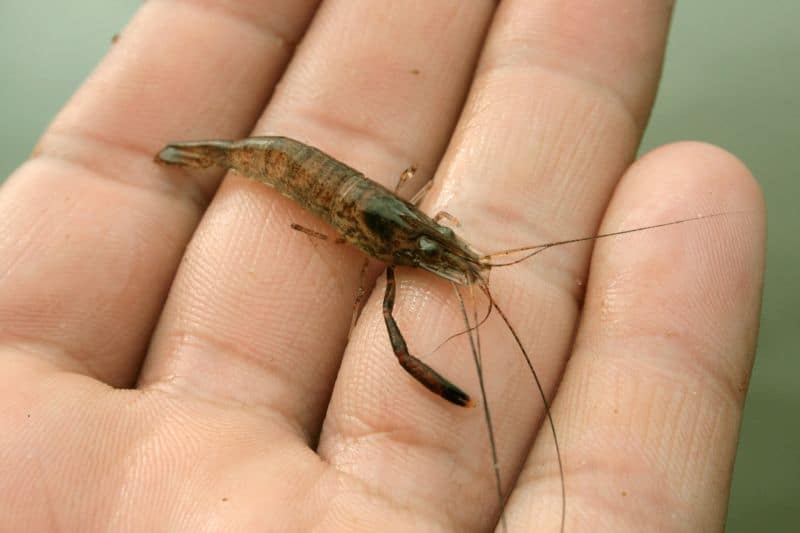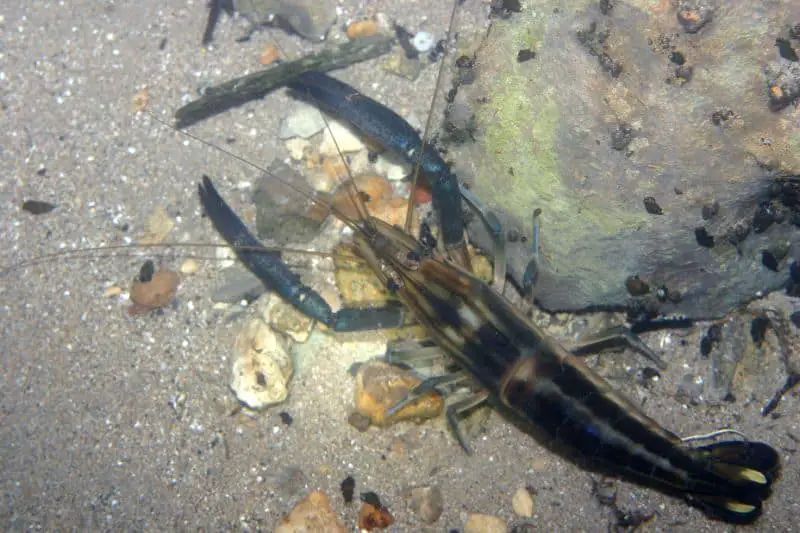River shrimp are pale to a translucent type of shrimp that survive in freshwater like the Ohio River Shrimp. You can add it to your tropical aquarium if you are looking for an interesting addition to it. Before you add them there are some things to consider to ensure that your tropical aquarium provides the right environment for the shrimp to survive. Tropical aquariums are usually heated, but the river shrimp won’t need it, they can live at room temperature. Understanding the natural habitat of the Ohio River Shrimp can assist you in making the necessary changes to improve your tropical tank for them.
Can River Shrimp Live in a Tropical Tank?
River shrimps can survive in large tropical aquariums that contain a variety of fish. River shrimp are natural scavengers, and they can survive on the remains of fish food and algae. However, you still need to buy food to ensure that they are getting their daily requirements.
You can keep river shrimp in a tropical aquarium, but there are a few conditions that have to be met to make them thrive. The most important ones are aquarium size, hiding spots, and tank mates.
River shrimp are great at keeping your aquarium clean at minimum effort on their part. There are a few conditions that are necessary to keep the river shrimp alive for a while. You need to consider creating favorable conditions for your river shrimp to keep them longterm.
What are River Shrimp?
Ohio River shrimp are pale shrimps with small blue dots on their bodies. Their scientific name is Macrobrachium ohione Source , and they grow up to 4-inches long. They have two pairs of claws, with the second pair being more significant than the first. The shrimp are commonly known as Ohio River Shrimp, although they are rare to find in Ohio River. You can find the shrimp in the states of North Carolina, Missouri, Louisiana, Florida, and Illinois.
, and they grow up to 4-inches long. They have two pairs of claws, with the second pair being more significant than the first. The shrimp are commonly known as Ohio River Shrimp, although they are rare to find in Ohio River. You can find the shrimp in the states of North Carolina, Missouri, Louisiana, Florida, and Illinois.


In the 1890s, the shrimp were food for poor French Acadian immigrants. In those days, the settlers near the Mississippi caught river shrimp worth millions of dollars, in their money, for food. Currently, the Ohio branch of River Mississippi doesn’t offer conducive conditions for river shrimp to survive. Engineering to straighten the river makes the river too fast for shrimp to migrate, and it dumps the silt and mud river shrimp need to survive in the ocean.
Requirements For Keeping River Shrimp in a Tropical Tank
Have you been asking yourself, ‘Can you keep river shrimp in a tropical aquarium?’ to improve your tank’s ecosystem?
River shrimp can survive and thrive in an ecosystem that includes other fish. They eat any fish food remain and algae that grow on the glass of an aquarium. They will also eat any dead fish or plants they come across.
They are fun to watch as they swim around or explore the various caves and nooks in your aquarium. Here are some of the requirements you need to consider to add river shrimp in your tropical tank successfully.
Tropical Tank Requirements
The Ohio River shrimp live in freshwater in their adult life but grow in salt water until they mature. You will need to know the development stage of the river shrimp you purchase before deciding the tank’s best living conditions. It is better to choose mature river shrimp since you can simply add then into a tank of fresh water.
You don’t have to worry about the bioload the shrimp will have on the tropical tank. It is likely to be minimal unless you add a massive number of shrimps in your tank. Most people use river shrimp for food or as bait while fishing. However, river shrimp can improve the quality of an ecosystem. They survive in low to medium lit environments and can live in water that is at room temperature.
The water should not contain any ammonia as river shrimp can’t survive in ammonia. Also, you need to ensure that the water contains little or no nitrates. Larger tropical tanks can sustain a reasonable PH level without the drastic changes in the environment. Smaller aquaria can be more difficult to keep, a small change the environmental conditions is harder to compensate in a small tank.
If you live in a place where the water is softer, you should also consider adding some calcium to keep the shells in mint conditions. You can add shells or crushed coral as a source of calcium in the tropical tank.
Capacity and Habitat
It is crucial to keep the right bioload depending on the size of your tropical tank. The rule of thumb is to keep 2-3 river shrimps for every 10-20 gallons of water. The shrimp need to have room to move around and explore their surroundings. Male species of river shrimp are highly territorial. You will need more space if you choose to have several males in a tank. Each male should have enough territory to move around without colliding with other male shrimp.
Consider placing PVC tubing pieces, tank plants, rocks, or clay pots that can be used as hiding spots for the shrimp when they feel in danger. It is a good idea to distribute the hiding places around the tropical aquarium to give them multiple spots to hide.
River Shrimp Tank Mates
Choosing the ideal tank mates for your river shrimp can be a bit tricky for beginners. Shrimp can be food for larger types of fish in the aquarium and the shrimp can devour small fish if they get too close to the shrimp. Fish that are the same size or smaller as the shrimp can be at risk of being eaten by the shrimp because they are omnivores and feeders of opportunity. Although fishes are generally faster than shrimp, they tend to slow down to sleep or rest, and the shrimp might find an opportunity to catch one ones in a while.
It is unlikely the River Shrimp will predate on all your fish in your aquarium or that they will catch any fish at all but it is something to watch out for.


You can opt for bigger fish that are herbivores so that they do not feed on the shrimp and are too strong to be prey. Alternatively, you can go for a fast reproducing fish like guppies. Guppies tend to multiply fast, and you won’t miss a few missing guppies.
You can always keep the river shrimp alone in the tropical tank if you don’t want any risk of casualties, but then you won’t need a heater and it would be hard to consider it a tropical tank.
Feeding River Shrimp
River shrimp are omnivores and require a balanced diet that includes protein. Te RIver Shrimp are feeders of opportunity and will eat everything from dying plants to leftover fish food. They will find all kinds of food in your aquarium, but you can supplement their diet with Shrimp food. You can also add brine shrimp or earthworms to their food as a treat, and as a protein source.
River shrimp that co-habit with fish will always scavenge for the remains of fish food to eat. It is easy to buy the ideal shrimp food to keep the river shrimp in perfect health. You won’t spend a fortune trying to feed the shrimp in your tropical tank. You can add some water plants or shrubs that the shrimp can nibble on and get the necessary nutrients. Generally, they won’t eat healthy plants but they will eat the dying and decaying leaves.
Breeding River Shrimp
River shrimp are amphidromous, meaning that there are phases they spend in saltwater and others in freshwater. Initially, Ohio River shrimp laid eggs in freshwater, the tide carries the eggs to the ocean water. Shrimp that hatched in the river had to swim to the ocean in days to ensure survival. Once the Ohio River shrimp were adults, they would swim back into the freshwater of the Mississippi River.
Another well-known type of shrimp that has a similar way of reproducing as the North American River Shrimp is the Amano Shrimp .
.
It is tough to recreate the ideal conditions for breeding Ohio River shrimp. It would take dedication, scientific types of equipment, and a lot of time to create the perfect reproduction conditions. Even after you create the ideal conditions, it will still produce a low turnover for the shrimp. It is better to buy adult shrimp for your tropical aquarium. If you decide to do captive breeding, you will need to transfer the eggs into another saline tank until they come of age. Keep in mind that shrimp eggs are food for other aqua creatures.
Why Should You Keep River Shrimp in a Tropical Tank?
A tropical tank is attractive when it has a variety of creatures in it. River shrimp are simple to maintain, and they do not need much care. It is a great way to add diversity to your tropical tank without increasing the expenses. Also, adding a few to a tank doesn’t significantly increase the bioload of a tank. The pale creatures can improve the overall environment of the tropical tank because they are scavengers.
It is essential to note that the Ohio River shrimp is significantly decreasing in numbers. You can keep the species as a way to ensure continuity in the future. You can choose to breed them and put them back in nature, but it will take time and dedication. Overall, they are an excellent addition to a tropical aquarium.
Conclusion
Sprucing up your aquarium with Ohio River shrimp or other River Shrimp can improve the aesthetic appeal of your tropical aquarium. The shrimp don’t require much care and maintenance, making them the perfect addition to a tropical tank.
It is always fun watching the shrimp dart from one area to the next in the aquarium as they explore. You can add useful features like caves and other hiding spots to enhance the habitat for the shrimp. It is nice to keep river fish in a tropical tank if you are looking for exciting creatures that do not require a lot of maintenance or attention.
Related Questions
Are River Shrimp feeder shrimp? River Shrimp can be Feeder Shrimp. Feeder shrimp can be any kind of shrimp you feed to your fish or other animals. Usually, Feeder Shrimp are fast reproducing shrimp, for example, Ghost Shrimp, Glass Shrimp, and in some cases, River Shrimp. Source
Why are ghost shrimp so cheap? Ghost Shrimp are often inexpensive because they are sometimes bred as feeder shrimp. As a feeder shrimp, they are reproduced on such a large scale that they become cheap.
